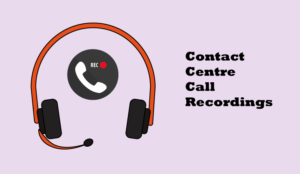Voice recordings can provide a great way of helping to train call centre staff.
We asked our experts about how to do it.
Many contact centres are sold state-of-the-art recording devices with as many whistles and bells as money can buy. And while voice recordings are an incredible tool, they are often misused.
As Head of Coaching for O2, I oversaw the installation of a system that could record millions of calls and produce more data than we’d ever seen before. But the real challenge was using call recordings to drive the changes we wanted for our customers rather than voice recording simply becoming an ‘admin task’ or, worse still, a big stick to beat the agent with.
Don’t select only bad calls
When only ‘bad’ calls are used, people know that they’ll get a kicking in a coaching session, which will result in a deflated advisor and a coach who has proven they know best. This type of victory is Pyrrhic as the performance of the agent is unlikely to change for the better.
Avoid ‘percentage’ scoring calls
Where possible, avoid ‘percentage’ scoring calls – they simply become an internal measure that subjectively skews the dashboard, allowing managers to self-congratulate. More often than not these have remarkably higher scores than independently scored calls and aren’t related to customer experience. Agree whether the call met the required standard and avoid getting into the minutiae of “you didn’t use the customer’s name three times so that’s four lost points”.
When deciding which aspect to coach on, ask yourself the following question – did the person know what they should have done but didn’t do it, or did they not know what’s required?
Essentially it’s the difference between coaching and training. The most common error in contact centres is that people re-train rather than coach. I’ve seen many occasions when an agent has a great level of performance, then has a ‘bad’ call and the coach will conduct a session that’s right back at the level of someone who just walked out of induction training – rather than an open discussion asking “what’s going on here?”
A coaching framework
Irrespective of whether it is a fabulous or disastrous recording that is the basis of the coaching session, the broad coaching framework is always the same:
1. Play the call together
2. Ask the agent what they thought of the call generally
3. Ask the agent what they thought was the best thing they did in it
4. Ask the agent what they think the customer experienced and how likely the
customer would be to use the service/product again
5. Ask the agent what they could do to improve the call
6. Now share your own opinion, including any score for the recording, if you have one
7. Choose one area to focus on using the SMART framework (Customer Service as a topic is too broad to cover in one coaching session)
8. Use whichever coaching model you follow to work on that one area and coach to improve performance
Coaching around call quality
Make practice part of the session. That way you’ll know during the session if they understand the expected level required and can deliver it. And ask the agent to report back on how well they’re doing by the end of the day rather than next month.
Keeping the customer experience in mind and viewing voice recordings as a chance for improvement rather than artificial self-congratulation or berating staff will help make this method a valuable tool in any contact centre.
Is Big Brother listening?
From an agent’s perspective, when call recording was initially introduced it was often seen as intrusive and a case of ‘Big Brother is Watching You’. Nowadays, it is commonplace, although there is still plenty of room for improvement in the quality aspect.
Voice recordings are a tool which can be used most effectively to evaluate the performance of contact centre agents, but to achieve the best results, they should be used to evaluate performance with a view to agents taking responsibility for their own development, rather than used as a means of compliance.
Listening live has its problems
As opposed to listening live or side by side at the desktop, voice recordings provide a much truer reflection of an advisor’s call handling. It is difficult for anyone to perform naturally while someone is sitting on top of them, although they are probably less likely to slip up and will stick to core brand messages. Even when you are listening live, but remotely, an agent’s conversation is more likely to be artificial and the chances are that the minute the supervisor takes off their headset, they will slip back into their old habits.
Random calls
Voice recordings also allow random calls to be picked for monitoring, providing a much more representative sample of what is actually going on in a contact centre. From a legal compliance point of view, in the event of a complaint or dispute, you can quickly and easily refer back to the activity and prove whether you have adhered to the agreed compliance or not.
The core advantage of voice recordings is that you can play and replay the calls to provide effective feedback during coaching sessions. They also provide the opportunity to highlight exceptional call quality, which can be used as best-practice examples in future training and development programmes.
However, unless you are prepared to run other processes alongside call recording as part of a continuous improvement and development programme, you could be spending a lot of money for nothing. It must be built around an environment of openness and trust and allow coaching within a framework where the advisor is empowered to access their own calls.
Positive feedback
This, with positive feedback and endorsement is frequently the catalyst for agents to take the initiative. They see it as enriching their role and giving them responsibility, particularly when linked into a career progression plan. The improvement in quality is tangible when an effective quality programme is rolled out and the manager secures the
buy-in of their team.
Using voice recording as part of your coaching toolbox allows you to make use of real-life examples of calls received and made.
Recorded calls can be played back at any time. Calls can be saved in mp3 format, which is easy to both store and email, you can deliver coaching on any type of call made or received. You can also email these recordings from colleague to colleague as required.
“Live monitoring”, where you wait for an agent to take “the right call” can waste lots of time. Instead you can listen to recorded calls in your own time and ‘rewind’ them to review contentious or crucial parts of a conversation.
“Side-by-side” monitoring can change an agent’s behaviour, particularly if they are nervous or self-conscious. Using voice recordings will also allow you to listen to your agents as they really are – without changing their behaviour.
Combining voice recording and call scoring technology will allow you to easily identify training requirements for individual agents and groups and overall allows you to evaluate training needs and effectiveness better.
We all know voice recording is a valuable tool for quality monitoring, compliance and dispute resolution but it is also important for coaching staff. Many team leaders and contact centre managers simply do not know how to maximise the use of voice recordings when coaching agents.
For example, there’s not much point trying to explain to an agent where they can improve, it’s a thousand times more effective to use a call recording to show a real-life example. This way it’s a lot clearer and the agent knows exactly where they need to improve.
Self-evaluation
Self-evaluation, where the agent listens to their own voice recordings, can be a useful way to coach staff as this gives them the opportunity to identify areas which they need to work on themselves. If they recognise the areas of concern this means they know what they need to do, but if they don’t, this might actually identify a problem area within the training programme, not necessarily in the agent.
Rapid-fire coaching
At the opposite end of the scale is a technique Business Systems likes to call ‘rapid-fire coaching’. This involves a group of agents, team managers, CSMs and trainers listening to calls together to discuss call-handling techniques and evaluate the quality of the call. These sessions help reinforce quality standards and allow new and experienced agents to share experiences, best practice and they provide a natural way to cross-skill agents from different departments. It is recommended that at least one ‘rapid-fire coaching’ session is held per month. Research has found that regular sessions can achieve anywhere from 5% to 20% higher quality scores than the overall contact centre average. These sessions can easily be integrated into team meetings and you’ll find a lot of agents won’t mind their calls being listened to, just make sure you ask for permission first! ‘Rapid-fire coaching’, when done in small groups or as part of a team briefing, is more cost effective and proactive than a one-to-one session – not to mention more enjoyable and less nerve racking for the agent.
By using voice recordings to coach call centre staff, sales conversions, call handling techniques and customer service can all be improved. Why not give it a go and see what results you can achieve?
Today there is a wealth of information on customer/agent interactions stored within contact centre systems. The challenge is being able to access it, turn it into valuable business intelligence and use it as a source for targeted training and employee development. Whilst sampling techniques can give us an idea of what is going on, speech analytics can access 100% of calls and provide a true picture of what is happening on the shop floor.
Highlighting the good calls
Call driver analysis reports can highlight where there are issues and also where processes are proving successful. Some advisors may be excellent in some areas but need help in others. With speech analytics good practices can be shared by drilling down directly to the relevant point in the call(s) and listening for the key points that made the call successful.
Pinpointing areas for improvement
By analysing 100% of calls an accurate picture of, for example, average handle time for particular types of calls, or the amount of non-speech time by advisor, can be clarified. On further drill-down this may elucidate gaps in product knowledge or areas of poor call control. Issues in broken processes or non-standard procedures across an organisation can push the numbers up but unless you know the root cause, effective corrective measures can’t be put in place.
Targeted training and development – individual training plans
If the problem is in simple product knowledge or ineffective procedures then theme-based coaching will do the trick. However, ‘vanilla’ training doesn’t fit all. Targeted training against specific issues saves time and money and utilises resource staff far more intelligently. Individual training plans can be developed against a person’s strengths and weaknesses.
In today’s market, productivity improvements is what drives businesses and getting ‘more for less’ from their contact centre systems and staff. Companies that have access to the wealth of information stored in their call recording system are able to build personalised training and development plans, make their staff feel valued members of a team, improve agent performance and reduce attrition.
Tagging calls
Most voice recording solutions have a tag feature which supports a basic search facility based on a number of definable fields such as policy number, incident reference or postcode. This can be extremely useful to trainers wanting to select specific sessions or for demonstrating the progression of an incident over time using a log of calls.
In addition to calls being identified according to standard criteria, field names can be modified to assist trainers and supervisors further. A good example is to define a search tag as either a ‘sale’ or a ‘no sale’. This can help to identify and analyse the calls that get results (and those that don’t) both quickly and easily.
The coaching tools available to trainers and supervisors have grown in number and sophistication, with many of them offering advanced features based on recording systems that support free seating. This is especially useful for larger call centres as it allows for immediate playback to a specific agent regardless of his or her location or the extension being used.
Agent evaluation
Along with call recording, many call centres have an agent ‘evaluation form’ which allows them to score the agent’s performance during the conversation. These forms cover all aspects of the call from call-handling skills, product knowledge and sales performance such as cross selling and closing.
Self assessment
Imagine the benefits to your organisation of allowing agents to perform self assessment or even giving them the ability to critique the team leader’s calls! It sends out the right message to your staff, it shows that you are willing to listen and that you are allowing them to participate in their future training, thus showing trust and, more importantly, commitment.
Further reading
- Call Quality Monitoring
- Typical Quality Monitoring features
- Call Center Quality Assurance
- Call Quality Evaluation
- Recording Customer Surveys
Contributors
- Simon Ireland-Davies of ID Coaching
- James Le Roth of Eclipse Marketing
- Cameron Ross of Veritape
- Brent Bischoff of Business Systems
- Jonathan Wax of Nexidia
- Carl Nancollas of Storacall
Author: Jonty Pearce
Published On: 17th Apr 2010 - Last modified: 14th Jun 2024
Read more about - Call Centre Management, Brent Bischoff, Business Systems, Coaching, Nexidia, Storacall





































I found this very helpful.